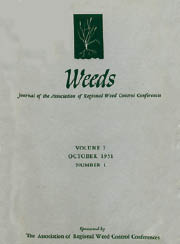Article contents
Chemical Studies on Halogeton glomeratus
Published online by Cambridge University Press: 12 June 2017
Extract
Halogeton glomeratus, a weed poisonous to animals, was first observed in the United States near Wells, Nevada, 1934–5. Dayton has given a detailed historical sketch concerning its European-Asiatic habitats and species. The ecology of halogeton has been discussed by Cook and Stoddard, Fenley and Tisdale and Zappettini. Very little is known in the English-speaking world about the present status of Halogeton glomeratus in Asia, where this species is reported to be endemic.
- Type
- Research Article
- Information
- Copyright
- Copyright © 1956 Weed Science Society of America
References
Literature Cited
2.
Burge, L. M.
Halogeton glomeratus, a poisonous plant in Nevada. Nevada State Department of Agric. Bull. (unnumbered.)
1950.Google Scholar
3.
Cook, C. W., and Stoddard, L. A.
The Halogeton Problem in Utah. Utah State Agric. Exp. Sta. Bull. 364. Nov. 1953.Google Scholar
4.
Dayton, W. A.
Historical sketch of barilla (Halogeton glomeratus). Jour. Range Mgt.
4: 375–81. 1951.Google Scholar
5.
Fenley, J. M.
How to live with Halogeton. Univ. of Nevada Agric. Ext. Service Bull. 106. 1952.Google Scholar
6.
Fleming, C. E., Miller, M. R., and Vawter, L. R.
Project 22. Poisonous Range Plants—Halogeton glomeratus
. Nev. Agr. Exp. Sta. Ann. Reports.
1943–50.Google Scholar
7.
Miller, M. R.
Halogeton glomeratus, poisonous to sheep. Science
97: 262. 1943.CrossRefGoogle ScholarPubMed
8.
Tisdale, E. W., and Zappettini, George. Halogeton Studies on Idaho ranges. Jour. Range Mgt.
6: 225–36. 1953.CrossRefGoogle Scholar
- 49
- Cited by


